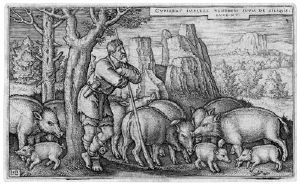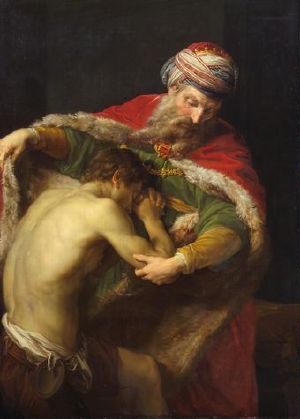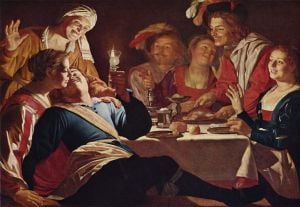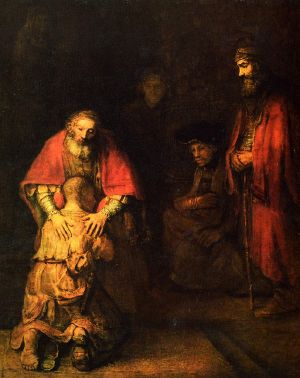Difference between revisions of "Parable of the Prodigal Son" - New World Encyclopedia
m (Robot: Remove claimed tag) |
(import new version) |
||
| Line 1: | Line 1: | ||
| + | [[Image:Pompeo Batoni 003.jpg|thumb|right|''The Return of the Prodigal Son'' (1773) by [[Pompeo Batoni]]]] | ||
| + | The '''Prodigal Son''', also known as the '''Lost Son''', is one of the best known [[parable]]s of [[Jesus]]. It appears only in the [[Gospel of Luke]], in the [[New Testament]] of the [[Bible]]. By tradition, it is usually read on the third Sunday of [[Lent]]. It is the third and final member of a trilogy, following the [[Parable of the Lost Sheep]] and the [[Parable of the Lost Coin]]. | ||
| − | + | ==Overview== | |
| − | + | The story is found in {{bibleverse-lb||Luke|15:11-32|}}. Jesus tells the story of a man who has two sons. The younger demands his share of his inheritance while his father is still living, and goes off to a distant country where he "waste[s] his substance with riotous living", and eventually has to take work as a [[swine]] herder (clearly a low point, as swine are not kosher in Judaism). There he comes to his senses, and decides to return home and throw himself on his father's mercy, thinking that even if his father does disown him, that being one of his servants is still far better than feeding pigs. But when he returns home, his father greets him with open arms, and hardly gives him a chance to express his repentance; he kills a fatted calf to celebrate his return. The older brother becomes jealous at the favored treatment of his faithless brother and upset at the lack of reward for his own faithfulness. But the father responds:{{quotation|Son, thou art ever with me, and all that I have is thine. It was meet that we should make merry, and be glad: for this thy brother was dead, and is alive again; and was lost, and is found. |(Luke 15:32, [[King James Version of the Bible|KJV]])}} | |
| − | The | + | The [[Eastern Orthodox Church]] traditionally reads this story on the Sunday of the Prodigal Son,{{Fact|date=March 2007}} which in their [[liturgical year]] is the Sunday before Meatfare Sunday and about two weeks before the beginning of [[Great Lent]]. One common ''kontakion'' [[hymn]] of the occasion reads,{{quotation|I have recklessly forgotten Your glory, O Father;<br>And among sinners I have scattered the riches which You gave to me.<br>And now I cry to You as the Prodigal:<br>I have sinned before You, O merciful Father;<br>Receive me as a penitent and make me as one of Your hired servants.}}[[Pope John Paul II]] explored the issues raised by this parable in his second encyclical [[Dives in Misericordia]] (Latin for "Rich in Mercy") issued in 1980. |
| − | + | ==The dual challenge== | |
| − | + | Within the context of Luke 15, these three parables — the Lost Sheep, the Lost Coin, and the Lost Son — make up a dual plea for repentance to the audience of [[Publican]]s and [[sin]]ners and a rebuttal to the listening [[Pharisee]]s, according to [[I. Howard Marshall]]. {{Fact|date=May 2008}} | |
| − | |||
| − | |||
| − | |||
| − | |||
| − | ==The dual challenge | ||
| − | Within the context of Luke 15, these three parables — the Lost Sheep, the Lost Coin, and the Lost Son — make up a dual plea for repentance to the audience of | ||
| − | |||
The Pharisees' accusation to Jesus had been: "This man welcomes [[sinners]] and eats with them." They may have been referring obliquely to [[Psalm]] 1:1:{{quotation|Blessed is the man | The Pharisees' accusation to Jesus had been: "This man welcomes [[sinners]] and eats with them." They may have been referring obliquely to [[Psalm]] 1:1:{{quotation|Blessed is the man | ||
| − | <br>who does not walk in the counsel of the wicked<br>or stand in the way of sinners<br>or sit in the seat of mockers.}}Their | + | <br>who does not walk in the counsel of the wicked<br>or stand in the way of sinners<br>or sit in the seat of mockers.}} Their reaction to Jesus associating with sinners was equivalent to the reaction of the faithful son in the parable. |
| − | |||
| − | |||
| − | |||
| − | |||
| − | |||
| − | |||
| − | |||
| − | |||
| − | |||
| − | |||
| − | |||
| − | |||
| − | |||
| − | |||
| − | |||
| − | |||
| − | |||
| − | |||
| − | |||
| − | |||
| − | |||
| − | |||
| − | |||
| − | |||
| − | |||
| − | [[ | + | == In the arts == |
| + | [[Image:Sebald Beham Der verlorene Sohn hütet seine Schweine.jpg|thumb|[[Hans Sebald Beham]], 1538, [[engraving]]]] | ||
| + | [[Image:Gerard van Honthorst 004.jpg|thumb|[[Gerard van Honthorst]], 1623, like many works of the period, allows a genre scene with moral content.]] | ||
| + | [[Image:Rembrandt Harmensz. van Rijn 125.jpg|thumb|[[Rembrandt]], ''Return of the Prodigal Son'', 1662, ([[Hermitage Museum]], [[St Petersburg]])]] | ||
| + | [[Image:ReturnOfTheProdigalSon-IW.jpg|thumb|right|''The Return of the Prodigal Son'' by [[Ivor Williams]] (1908-1982)]] | ||
| + | The story of the prodigal son has been depicted many times by later Christians, in many media. Of the thirty or so parables in the canonical Gospels, it was one of the four that were shown in medieval art almost to the exclusion of the others, but not mixed in with the narrative scenes of the ''[[Life of Christ]]'' (the others were the [[Wise and Foolish Virgins]], [[Dives and Lazarus]], and the [[Good Samaritan]].<ref>Emile Mâle, The Gothic Image , Religious Art in France of the Thirteen Century, p 195, English trans of 3rd edn, 1913, Collins, London (and many other editions)</ref> The [[Labourers in the Vineyard]] also appears in [[Early Medieval]] works). From the Renaissance the numbers shown widened slightly, and the various scenes - the high living, herding the pigs, and the return - of the Prodigal Son became the clear favourite. [[Albrecht Dürer]] made a famous [[engraving]] of the Prodigal Son amongst the pigs (1496), a popular subject in the [[Northern Renaissance]], and [[Rembrandt]] depicted the story several times, although at least one of his works, ''[[The Prodigal Son in the Tavern]]'', a portrait of himself "as" the Son, revelling with his wife, is like many artists' depictions, a way of dignifying a genre tavern scene. His late ''Return of the Prodigal Son'' (1662,[[Hermitage Museum]], [[St Petersburg]]) is one of his most popular works. | ||
| − | The | + | The story was the most common subject of the English [[morality play]], which is the precursor of [[Elizabethan theatre]]. |
| − | + | Notable adaptations for performance include a 1929 ballet by [[Sergei Prokofiev]] and [[The Prodigal Son (Sullivan)|an 1869 oratorio]] by [[Arthur Sullivan]]. Many of these adaptations considerably added to the Biblical material to lengthen the story; for example, the 1955 film ''[[The Prodigal]]'' took considerable liberties, such as adding a temptress priestess of [[Astarte]] to the tale. | |
| − | " | + | The parable has also often been revisited in songs, which alleviates the need for additional material. More oblique adaptations include ''Prodigal Blues'', a song by [[Billy Idol]] that compares the singer's struggles with drug addiction to the parable, and the musical ''[[Godspell]]'', which re-enacts the Prodigal Son story as a [[Western film]]. [[Bono]], the vocalist of the Irish band [[U2]], wrote the song "[[The First Time]]" based on this parable. Musician [[Dustin Kensrue]], also of [[Thrice]] fame wrote a song about the Prodigal Son entitled ''Please Come Home'' of the album of the same name released in [[2007]]. The British heavy metal band [[Iron Maiden]] recorded a song, ''Prodigal Son'', based on the parable of the same name, which appeared on their second release ''Killers'' in 1981. In 1978, reggae band Steel Pulse recorded a song entitled "Prodigal Son", which transposes the story of the prodigal onto the slave trade, and suggests that their real "homecoming" was in fact to be spiritual rather than physical, a "homecoming" through religion (Rastafari). (Edited By James Mariotti-Lapointe) The Reverend [[Robert Wilkins]] told the story of this parable in the song "Prodigal Son," which is probably best known as a cover version by the [[Rolling Stones]] on their 1968 album [[Beggar's Banquet]]. The Nashville Bluegrass Band recorded "Prodigal Son" as an a capella bluegrass gospel tune (which leaves out the brother). |
| − | [[ | + | ''"Juan en la Ciudad"'' (John in the City), a salsa-merengue fusion that describes the parable in condensed terms, was [[Richie Ray]]'s and [[Bobby Cruz]]'s most popular hit ever, in 1977. |
| − | + | Perhaps the most profound literary tribute to this parable is Dutch theologian Henri Nouwen's 1992 book, ''The Return of the Prodigal Son, A Story of Homecoming''. In the book, Nouwen describes his own spiritual journey infused with understanding based on an encounter with Rembrandt van Rijn's painting of the return of the Prodigal. He shows how the story is illuminated by the painting and is really about three personages: the younger, prodigal son; the self righteous, resentful older son; and the compassionate father. Nouwen describes how all Christians—himself included—struggle to free themselves from the weaknesses inherent in both brothers and are destined to find themselves becoming the all-giving, all-forgiving, sacrificial father. | |
| − | + | ==Bibliography== | |
| − | + | *D. A. Holgate, Prodigality, Liberality and Meanness: The Prodigal Son in Greco-Roman Perspective. Sheffield, 1999. | |
| − | + | *T. E. Phillips, Reading Issues of Poverty and Wealth in Luke-Acts. Lewiston, 2001. | |
| − | + | *W. Pöhlmann, Der Verlorene Sohn und das Haus: Studien zu Lukas 15,11-32 im Horizont der Antiken Lehre von Haus, Erziehung und Ackerbau. Tübingen, 1993. | |
| − | |||
| − | |||
| − | |||
| − | |||
| − | |||
| − | |||
| − | |||
==External links== | ==External links== | ||
{{commonscat|Prodigal son}} | {{commonscat|Prodigal son}} | ||
* [http://www.biblegateway.com/passage/?search=Luke%2015:11-32;&version=31; The story online] | * [http://www.biblegateway.com/passage/?search=Luke%2015:11-32;&version=31; The story online] | ||
| + | * [http://www.pravmir.com/article_260.html The Prodigal Son, comment by Rev. George Dimopoulos, Orthodox Portal] | ||
| + | * [http://www.catholic.org/featured/headline.php?ID=4160 Father Cantalamessa on the Prodigal Son] | ||
| + | * [http://www.eprodigals.com The Prodigal Son, comments by Kenneth E. Bailey] | ||
| + | {{Parables of Jesus}} | ||
| − | |||
[[category:Art, music, literature, sports and leisure]] | [[category:Art, music, literature, sports and leisure]] | ||
| − | {{credits|Parable_of_the_Prodigal_Son| | + | {{credits|Parable_of_the_Prodigal_Son|2430737000}} |
Revision as of 01:57, 6 October 2008
The Prodigal Son, also known as the Lost Son, is one of the best known parables of Jesus. It appears only in the Gospel of Luke, in the New Testament of the Bible. By tradition, it is usually read on the third Sunday of Lent. It is the third and final member of a trilogy, following the Parable of the Lost Sheep and the Parable of the Lost Coin.
Overview
The story is found in Luke 15:11-32. Jesus tells the story of a man who has two sons. The younger demands his share of his inheritance while his father is still living, and goes off to a distant country where he "waste[s] his substance with riotous living", and eventually has to take work as a swine herder (clearly a low point, as swine are not kosher in Judaism). There he comes to his senses, and decides to return home and throw himself on his father's mercy, thinking that even if his father does disown him, that being one of his servants is still far better than feeding pigs. But when he returns home, his father greets him with open arms, and hardly gives him a chance to express his repentance; he kills a fatted calf to celebrate his return. The older brother becomes jealous at the favored treatment of his faithless brother and upset at the lack of reward for his own faithfulness. But the father responds:
Son, thou art ever with me, and all that I have is thine. It was meet that we should make merry, and be glad: for this thy brother was dead, and is alive again; and was lost, and is found.
(Luke 15:32, KJV)
The Eastern Orthodox Church traditionally reads this story on the Sunday of the Prodigal Son,[citation needed] which in their liturgical year is the Sunday before Meatfare Sunday and about two weeks before the beginning of Great Lent. One common kontakion hymn of the occasion reads,
I have recklessly forgotten Your glory, O Father;
And among sinners I have scattered the riches which You gave to me.
And now I cry to You as the Prodigal:
I have sinned before You, O merciful Father;
Receive me as a penitent and make me as one of Your hired servants.
Pope John Paul II explored the issues raised by this parable in his second encyclical Dives in Misericordia (Latin for "Rich in Mercy") issued in 1980.
The dual challenge
Within the context of Luke 15, these three parables — the Lost Sheep, the Lost Coin, and the Lost Son — make up a dual plea for repentance to the audience of Publicans and sinners and a rebuttal to the listening Pharisees, according to I. Howard Marshall. [citation needed]
The Pharisees' accusation to Jesus had been: "This man welcomes sinners and eats with them." They may have been referring obliquely to Psalm 1:1:
Blessed is the man
who does not walk in the counsel of the wicked
or stand in the way of sinners
or sit in the seat of mockers.
Their reaction to Jesus associating with sinners was equivalent to the reaction of the faithful son in the parable.
In the arts

The story of the prodigal son has been depicted many times by later Christians, in many media. Of the thirty or so parables in the canonical Gospels, it was one of the four that were shown in medieval art almost to the exclusion of the others, but not mixed in with the narrative scenes of the Life of Christ (the others were the Wise and Foolish Virgins, Dives and Lazarus, and the Good Samaritan.[1] The Labourers in the Vineyard also appears in Early Medieval works). From the Renaissance the numbers shown widened slightly, and the various scenes - the high living, herding the pigs, and the return - of the Prodigal Son became the clear favourite. Albrecht Dürer made a famous engraving of the Prodigal Son amongst the pigs (1496), a popular subject in the Northern Renaissance, and Rembrandt depicted the story several times, although at least one of his works, The Prodigal Son in the Tavern, a portrait of himself "as" the Son, revelling with his wife, is like many artists' depictions, a way of dignifying a genre tavern scene. His late Return of the Prodigal Son (1662,Hermitage Museum, St Petersburg) is one of his most popular works.
The story was the most common subject of the English morality play, which is the precursor of Elizabethan theatre.
Notable adaptations for performance include a 1929 ballet by Sergei Prokofiev and an 1869 oratorio by Arthur Sullivan. Many of these adaptations considerably added to the Biblical material to lengthen the story; for example, the 1955 film The Prodigal took considerable liberties, such as adding a temptress priestess of Astarte to the tale.
The parable has also often been revisited in songs, which alleviates the need for additional material. More oblique adaptations include Prodigal Blues, a song by Billy Idol that compares the singer's struggles with drug addiction to the parable, and the musical Godspell, which re-enacts the Prodigal Son story as a Western film. Bono, the vocalist of the Irish band U2, wrote the song "The First Time" based on this parable. Musician Dustin Kensrue, also of Thrice fame wrote a song about the Prodigal Son entitled Please Come Home of the album of the same name released in 2007. The British heavy metal band Iron Maiden recorded a song, Prodigal Son, based on the parable of the same name, which appeared on their second release Killers in 1981. In 1978, reggae band Steel Pulse recorded a song entitled "Prodigal Son", which transposes the story of the prodigal onto the slave trade, and suggests that their real "homecoming" was in fact to be spiritual rather than physical, a "homecoming" through religion (Rastafari). (Edited By James Mariotti-Lapointe) The Reverend Robert Wilkins told the story of this parable in the song "Prodigal Son," which is probably best known as a cover version by the Rolling Stones on their 1968 album Beggar's Banquet. The Nashville Bluegrass Band recorded "Prodigal Son" as an a capella bluegrass gospel tune (which leaves out the brother).
"Juan en la Ciudad" (John in the City), a salsa-merengue fusion that describes the parable in condensed terms, was Richie Ray's and Bobby Cruz's most popular hit ever, in 1977.
Perhaps the most profound literary tribute to this parable is Dutch theologian Henri Nouwen's 1992 book, The Return of the Prodigal Son, A Story of Homecoming. In the book, Nouwen describes his own spiritual journey infused with understanding based on an encounter with Rembrandt van Rijn's painting of the return of the Prodigal. He shows how the story is illuminated by the painting and is really about three personages: the younger, prodigal son; the self righteous, resentful older son; and the compassionate father. Nouwen describes how all Christians—himself included—struggle to free themselves from the weaknesses inherent in both brothers and are destined to find themselves becoming the all-giving, all-forgiving, sacrificial father.
Bibliography
- D. A. Holgate, Prodigality, Liberality and Meanness: The Prodigal Son in Greco-Roman Perspective. Sheffield, 1999.
- T. E. Phillips, Reading Issues of Poverty and Wealth in Luke-Acts. Lewiston, 2001.
- W. Pöhlmann, Der Verlorene Sohn und das Haus: Studien zu Lukas 15,11-32 im Horizont der Antiken Lehre von Haus, Erziehung und Ackerbau. Tübingen, 1993.
External links
- The story online
- The Prodigal Son, comment by Rev. George Dimopoulos, Orthodox Portal
- Father Cantalamessa on the Prodigal Son
- The Prodigal Son, comments by Kenneth E. Bailey
| |||||
Credits
New World Encyclopedia writers and editors rewrote and completed the Wikipedia article in accordance with New World Encyclopedia standards. This article abides by terms of the Creative Commons CC-by-sa 3.0 License (CC-by-sa), which may be used and disseminated with proper attribution. Credit is due under the terms of this license that can reference both the New World Encyclopedia contributors and the selfless volunteer contributors of the Wikimedia Foundation. To cite this article click here for a list of acceptable citing formats.The history of earlier contributions by wikipedians is accessible to researchers here:
The history of this article since it was imported to New World Encyclopedia:
Note: Some restrictions may apply to use of individual images which are separately licensed.
- ↑ Emile Mâle, The Gothic Image , Religious Art in France of the Thirteen Century, p 195, English trans of 3rd edn, 1913, Collins, London (and many other editions)




